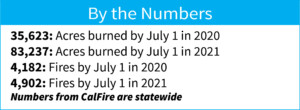Editorial: Prepare now for natural disasters, especially wildfires
The American Red Cross recommends Californians prepare well ahead of a devastating earthquake.

Morgan Hill Life file photo
California Conservation Corps Corpsmember Riley Gilmartin uses a fusee to help burn grass along a hand line to keep the fire from spreading to nearby ranch homes during the 2020 SCU Lightning Complex Fire.
Editorial is the opinion of Gilroy Life
California has been described as the land of “shake and bake.” Earthquakes keep our cities and towns trembling while wildfires burn the landscape. Here in South Valley, we are not immune to either of these natural disasters that can potentially endanger our lives.
It’s vital for public safety that as many residents as possible be prepared for the potential devastation that might come from a major earthquake or a wall of flames heading toward their homes. Adequate preparation to deal with these types of incidents will increase the likelihood of more effectively handling these emergencies if they happen, thus saving lives.
 We live close to the San Andreas and other geological fault lines. There’s always a possibility the region might unexpectedly be severely jolted by the massive amount of energy released by planet Earth. Recently, we were reminded of that fact when people throughout Northern California felt a 6.0 magnitude earthquake that rattled Little Antelope Valley (in the Eastern Sierra Nevada range) the afternoon of July 8.
We live close to the San Andreas and other geological fault lines. There’s always a possibility the region might unexpectedly be severely jolted by the massive amount of energy released by planet Earth. Recently, we were reminded of that fact when people throughout Northern California felt a 6.0 magnitude earthquake that rattled Little Antelope Valley (in the Eastern Sierra Nevada range) the afternoon of July 8.
The American Red Cross recommends Californians prepare well ahead of a devastating earthquake. Among its recommendations is to create a family emergency communications plan that has an out-of-state contact. It also advises families to choose a place to meet if separated. It’s smart to make a supply kit that can help your family survive. This should include a flashlight, a fire extinguisher and a whistle, non-perishable foods, cleaning supplies, and water for several days in case services are cut off in your area. Also include supplies to address minor medical issues at home, alleviating the burden on urgent care centers and hospitals. (see www.redcross.org/get-help/how-to-prepare-for-emergencies/survival-kit-supplies.html).
 This preparation can also be used in the events of a major wildfire. Last year, a record 4.3 million acres burned across California. That’s 1 out of every 24 acres in the state. The danger of a catastrophic fire is a local one. As we saw in the summer of 2020 when the flames ate away at Henry W. Coe State Park and other nearby wilderness areas, the South Valley faces the threat of an inferno fueled by our dry grasslands.
This preparation can also be used in the events of a major wildfire. Last year, a record 4.3 million acres burned across California. That’s 1 out of every 24 acres in the state. The danger of a catastrophic fire is a local one. As we saw in the summer of 2020 when the flames ate away at Henry W. Coe State Park and other nearby wilderness areas, the South Valley faces the threat of an inferno fueled by our dry grasslands.
California experienced two consecutive record-dry winters, significantly cutting the water supply for nearly all the state. As a result, 85 percent of the state now faces an extreme drought, according to the U.S. Drought Monitor, a weekly report issued by the U.S. Department of Agriculture, NOAA and the University of Nebraska.
In June Californians endured early heat waves with temperatures climbing higher than 110 degrees, including here in South Valley. This left grasses, brush and other vegetation dangerously dry. Our region is primed to burn as we now head into the hottest summer months. The danger of fire will go well into fall. With global warming’s effects on weather patterns, we will be sure to have to endure uncomfortably hot days through at least the end of September.
 Many of last summer’s fires were ignited during rare dry lightning storms in August that hit the Bay Area. The flames killed 33 people and destroyed more than 10,000 homes. As skies turned an eerie orange color, the smoke-filled air caused problems for people with health issues.
Many of last summer’s fires were ignited during rare dry lightning storms in August that hit the Bay Area. The flames killed 33 people and destroyed more than 10,000 homes. As skies turned an eerie orange color, the smoke-filled air caused problems for people with health issues.
This year’s wildfire season might be just as devastating because of the extreme heat and dry conditions. The pace of wildfires throughout California is already running ahead of last year. For the first six months of this year, 4,902 wildfires have burned on state, federal and private land. That’s 720 more fires than the same time period a year ago, according to records at the National Interagency Fire Center in Boise. This year’s fires have consumed 83,237 acres statewide. Last year, 35,623 acres had burned by July 1 across the state.
Earthquakes and fires threaten our quality of life. Let’s act wisely and take steps to deal with these natural disaster emergencies ahead of time. Lives are on the line.
